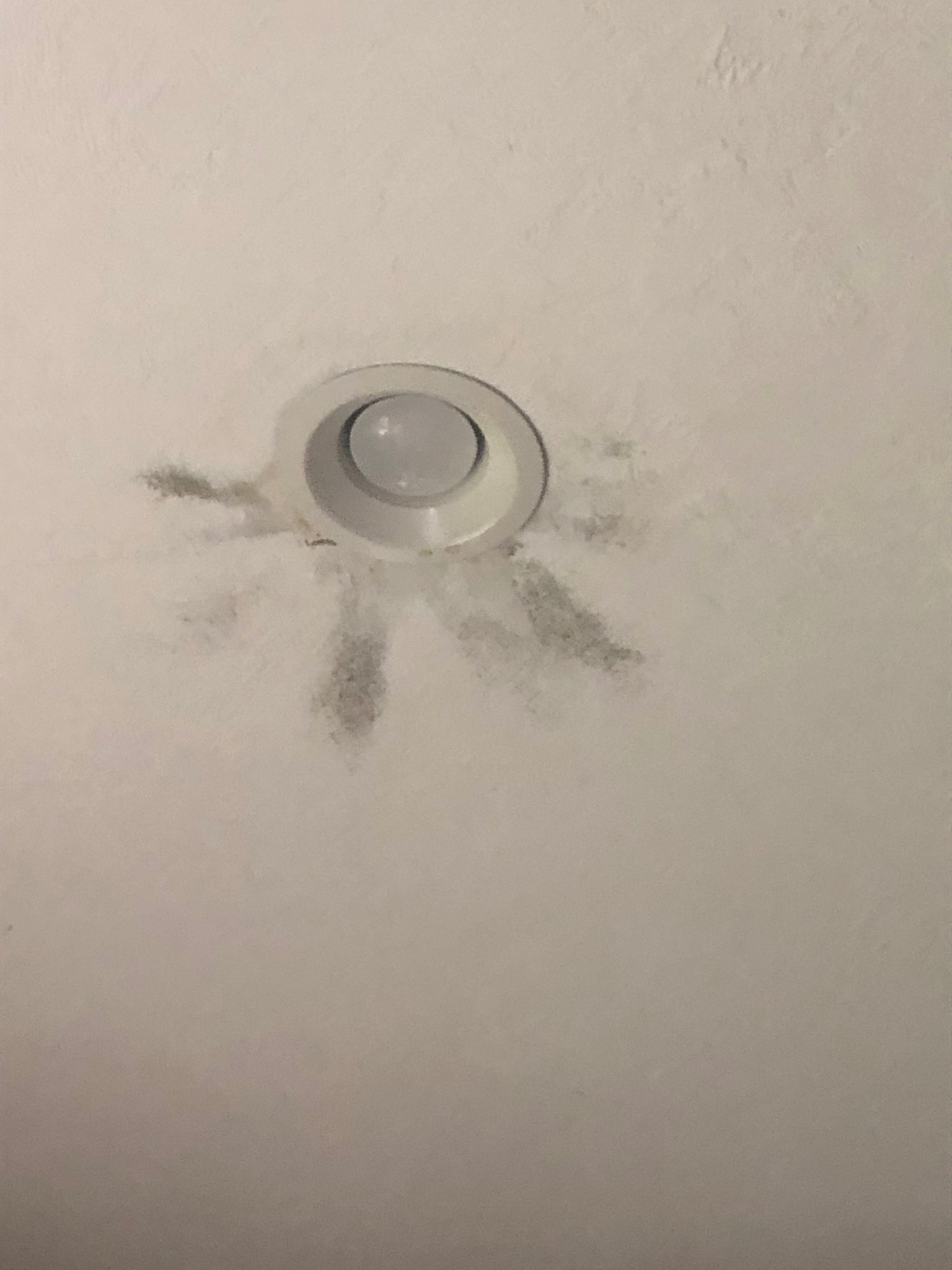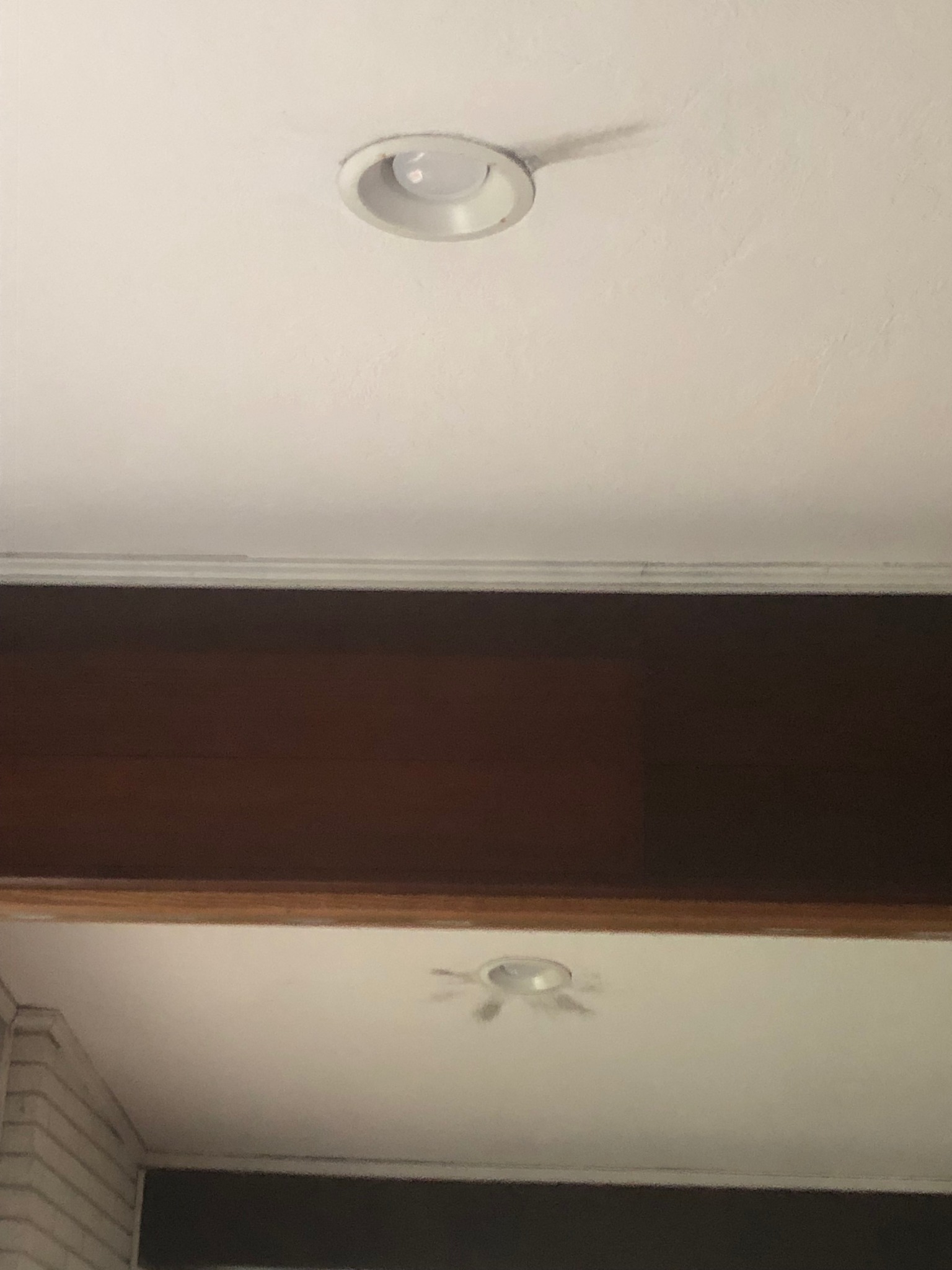Why are my can lights experiencing mold growth after replacing old windows in my 60s home?
Has anyone else experienced this issue? I’m really curious as to why my can lights are looking like this. Our house was built in the late 60s, and we had these lights put in about 7 years ago. Last fall, we replaced all our old aluminum windows with new ones. Some of the lights now have this weird appearance. In the spring, I tried painting over the moldy-looking part with a special primer, but it didn’t seem to help much. When we removed one of the lights, we didn’t see any mold or damage to the plaster. This is how they look today.
I have a couple of theories about what might be causing this. One is that the tight seal from the new windows is somehow pulling air from the ceiling behind the lights. The other theory is that the temperature difference between outside and inside is causing condensation around the lights, especially since there’s no insulation between them and the roof right above. It’s all a bit puzzling to me.


I don’t think natural airflow can explain this. I believe the central air system might be the culprit, drawing air from the closest and easiest locations mechanically due to the nearby return. The warm, moist air is meeting the cool, dry air, leading to condensation and mold growth. The newer can-less hi hats on the market have built-in gaskets on the ring, so ensuring proper air sealing for the existing ones is crucial. If you can access the area above, use a spray foam gun to seal every seam, wall, electrical, plumbing, and fixture possible. If the attic is unconditioned (no heating or cooling), it requires insulation. Aim for at least R30, with higher levels depending on the region. If you’re noticing this issue there, there’s a high chance it’s happening behind the walls as well.
There’s a high likelihood that is right on target.
Doesn’t make any sense
Might as well be a roof with a leak. That leads to a warm and moist setting, I’ve witnessed it on a construction site.
Care to elaborate?
Dealing with a leaky roof in the heat?
I’m based in Ohio, working as a service plumber. Summers can get scorching hot here, but I’ve never come across anything like this before.
Ellaed is fully backing this.
Poor insulation, warm and humid air from the attic is seeping in through the light fixture and may cause condensation leading to mold growth or dirt buildup. I recommend checking the insulation and ensuring the attic vents are unobstructed. Also, make sure the attic fan is functioning properly.
Do you know what the humidity level is in your attic?
I think Theory 2 makes sense. Insulating the attic is necessary.
Noticing some mold beginning to develop. Improve insulation around the can. The warm air leaking from the attic is entering the conditioned space, leading to moisture buildup and condensation that is resulting in mold growth.
Haha, we experienced this once!
You might notice similar markings on outlets located on exterior walls or next to the carpet by an exterior wall where air is seeping through the sill plate.
Use foam tape to seal the can trim. Make sure to check if there is insulation in the attic. The cans need to be IC rated if they are facing an attic space. IC rating means they can be in contact with insulation
Insulation in the attic is necessary, and it’s important to apply sealant behind the can light to restrict airflow
Let’s swap these cans for the slim LED lights and put insulation behind them
I agree. I believe there are even LEDs available that can be plugged into the existing fixture.
The main idea is not just to switch to LED lights, but to also make space for insulation in order to prevent condensation that can lead to mold growth. The slim LEDs can be clipped onto the Sheetrock, come with a small power box, and do not create uninsulated voids like can lights do. This allows for insulation.
The electrician actually removed the insulation above my LED lights because they were concerned about overheating.
But yeah, insulation is definitely necessary. So, are you telling me that your roof has no insulation at all?!?
Does your attic have proper ventilation? If you’re in an area with snowy winters and it’s not vented properly, it can lead to ice dams, which damage the shingles and result in leaks. Insulation around the can light shouldn’t impact moisture and mold growth, but poor ventilation and a leaky roof definitely can. It’s likely the cause of the issues. Attics require airflow from the soffit to the peak to prevent condensation and mold problems
I heard they have insulation covers for can lights now. LED bulbs don’t produce heat and the insulation material is non-flammable (like rockwool, I believe).
Why do you believe they don’t heat up? The LED may not, but have you considered the transformer?
They can get a bit warm but not too hot, and LED can lights are IC rated unlike some incandescent ones. This can prevent a big risk of fire.
Before painting, did you remove the mold or just cover it up with the mold-resistant primer?
If the issue began after the windows were installed, my guess would be air circulation and dust. If there’s mold, it’s likely more severe on the inside or you’d notice moisture near the light.
Remove the light, sand the area down, repaint it, apply some silicone around the light, and then put it back in place.
You should probably call an electrician
Hey , this is like a DIY page, isn’t it? 🤔
I agree with ! Initially, I thought they were burn marks. Regardless of the cause, they definitely need some assistance. However, upon closer inspection, I believe it’s just dust and they should be able to handle that on their own.
Got it
Proper ventilation is key. Adding insulation or sealant can help prevent air flow and dust. Also, ensure your HVAC system is pulling in enough fresh air from outside to avoid creating negative air pressure indoors.
Bring down the trims and seal the gaps around the cans with caulk.
Be sure your recessed lights are IC rated for insulation contact.
Where are you located? Is there no insulation above you? That could be the root of your problem.
Your house is experiencing depressurization, likely due to an imbalance between supply and return airflow in rooms where you regularly close interior doors (meaning there is no way for air to return). It used to get replacement air from the old window leaks, but now the only option is likely pathways from the attic or the space on the other side of the ceilings in your pictures. The cold air comes in (assuming you are in a region where heating is needed at this time of year) and causes interior moisture to condense on cool surfaces, possibly mixed with particulates from the attic. The first step is to address the pressure problem by creating return air pathways. The next step is to seal the air leaks in your home.
Make sure there’s a thin foam seal around the light
The attic has some moisture in it
There is airflow emanating from the holes where the fixtures are located, carrying dust with it, hence the accumulation of dust on the ceiling. Apply caulking to seal it, and you’ll be all set.
Yes, this actually happened to me. My house was constructed in the 1940s. Just moisture.
The use of recessed light housings (cans) for homes is on the decline. The latest trend is Pancake lights. However, there are still millions, if not billions, of cans and other fixtures using screw-in light bulbs. In the USA, they are known as E26 or Edison base or medium Base. Assuming that 99% of these will switch to LED bulbs that offer similar performance to old incandescents, the dynamics of heat and airflow change significantly. For the better. Old cans burning 50-75 watt incandescent PAR, R, or BR shaped downlighting bulbs are often marked “do not cover with insulation” due to heat and fire concerns. An IC (insulated ceiling) recessed fixture is a can enclosed by a larger aluminum box that provides sufficient thermal separation, allowing for insulation to cover it according to the manufacturer (and UL, etc.). However, LED bulbs emit the same light output with only 1/4 to 1/5th of the wattage (meaning less heat). Let’s assume you previously used BR30 65 watt incandescent bulbs. The 30 indicates 30/8ths of an inch or 3.75 inches in diameter. Now, with LEDs, the equivalent bulb generates 7.5 watts of heat, not 65. That’s a significant heat reduction. So, even with old cans, insulation coverage is now feasible. For older lensed shower lights, ensure that the LED bulb package specifies “can be used in enclosed fixtures.” For new Pancake installations, it is important to ensure that the foam gasket effectively seals against airflow between the attic and the room cavity. However, due to foam aging, weak springs, or the sudden opening of a door, air leaks may occur. In my opinion, if you have attic access, it would be wise to cover the Pancake with a non-combustible container (such as a terra cotta pot instead of a galvanized steel planter, which could lead to condensation), then surround the pot with insulation. Keep the splice box/power supply outside the enclosure. By the way, always apply a mold killer before using mold-inhibiting primers or paints. This is quite lengthy. I apologize. Feel free to ask questions. I served as the Director of Product Design at a major lighting manufacturer for 17 years.
Are you thinking of adding more insulation to your attic?
Have you thought about installing an attic fan to help with the overall ventilation of your home? It can prevent mold problems caused by excess moisture.
Consider blowing in some insulation.
Swap out the trims for ones that come with seals